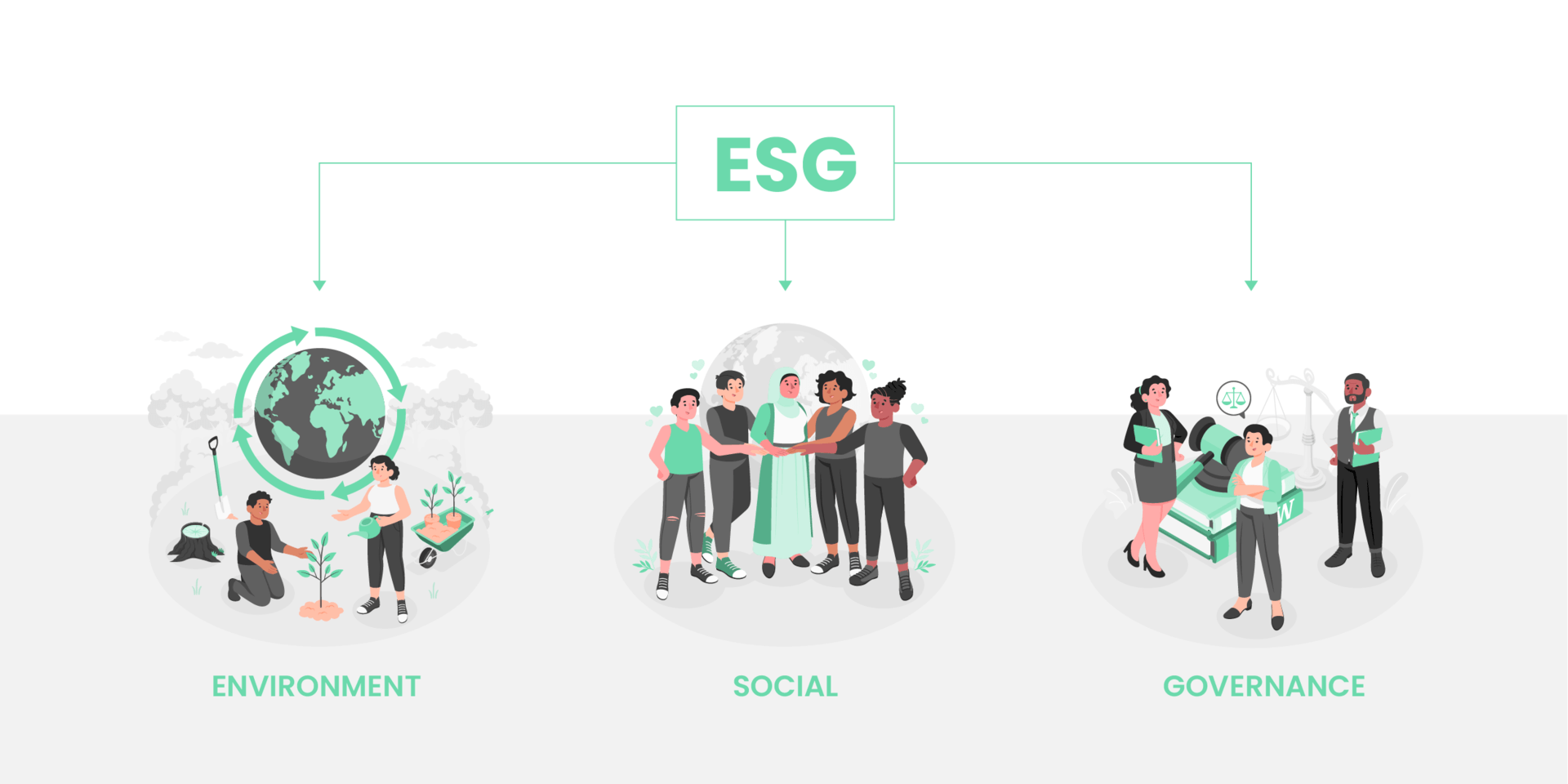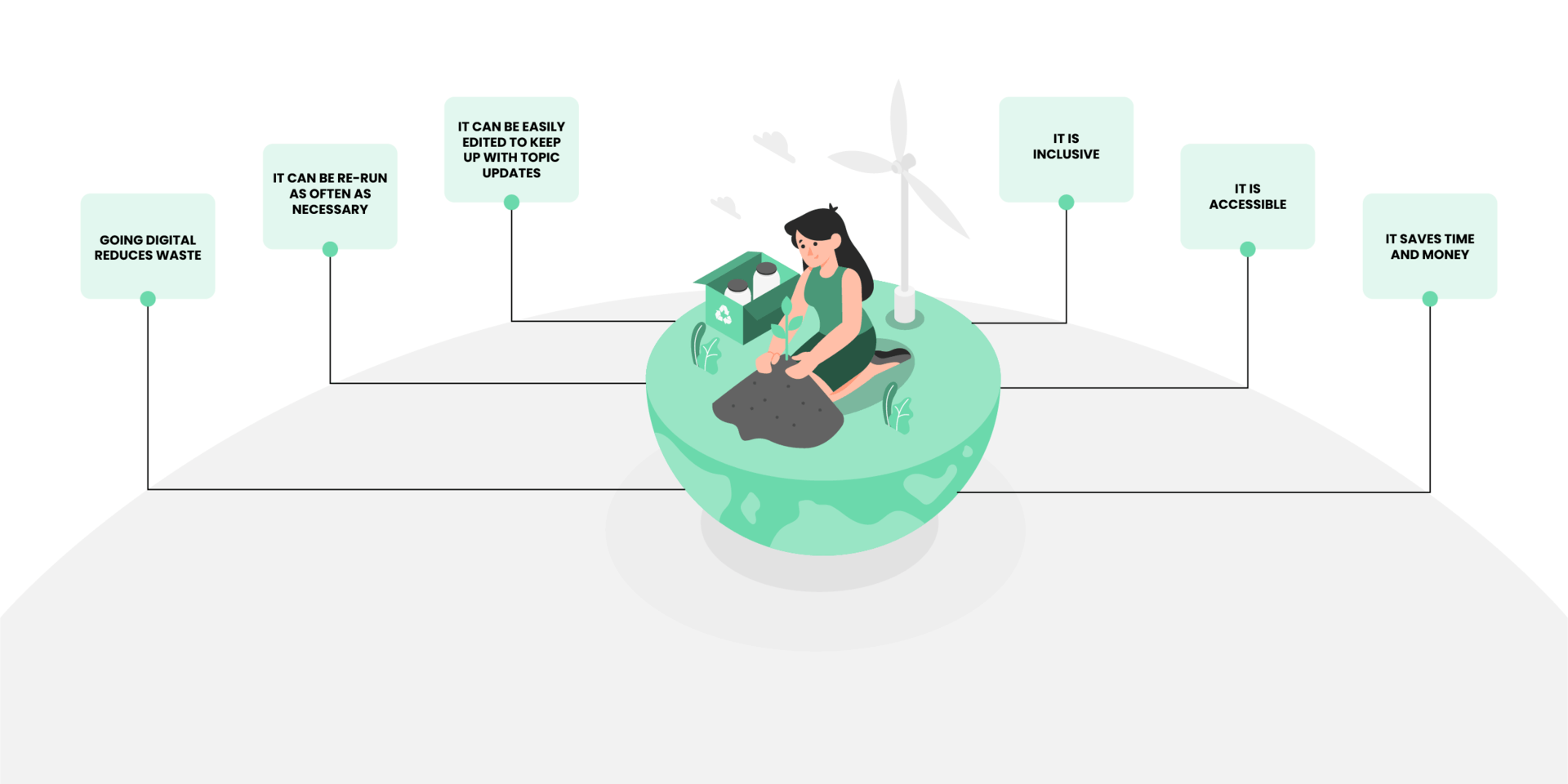Sustainable Learning On Sustainability
Although a huge trend in the corporate and investment world, ESG sustainability is touching everyone's lives, whether one admits it or not, which launches it beyond mere trends and poses it as a constant standard to be reached by organizations worldwide.
Given its all-present significance, it is to be expected that organizations strive for appropriate sustainability training. And what better way to train your employees on sustainability topics than to do it in a sustainable way? None, we say. eLearning is the only sensible tool.
Let's start this discussion with a brief enlightenment of the ESG abbreviation (and the abundant use of many sustainabilities, E's, S's, and G's).

The Sustainability Framework Of Today: ESG Meaning
ESG stands for "environmental, social, and governance," and these three concepts are sometimes called ESG factors or criteria. They provide a structured framework for stakeholders to better comprehend an organization's approach to addressing risks and opportunities pertaining to environmental, social, and governance considerations.
In its understanding of sustainability, ESG goes beyond environmental matters (it's more than just being eco-friendly) and takes a holistic view—this is what differentiates it from earlier sustainability initiatives. Also, another shift in the ESG framework is that it's not purely philanthropic, but it looks at these principles from the perspectives of opportunity and risk, which makes data quantifiable and more acceptable for investment practices (ESG investing). If you're still not on a first-name basis with ESG, we may suggest the explanations provided in the ESG article by Kyle Peterdy published by the Corporate Finance Institute.
This may be another way to put it: the ESG framework understands that each action within a business organization has repercussions on its daily operability and knows how to analyze those actions from the point of view of the three criteria (environmental, social, or governance).
Here is an example: in terms of the S, social, and G, governance, let's say that there is a high turnover rate in your organization due to unfair compensations. This implies that there are some management (governance) issues causing instability in the HC management area. Consequently, the company is unstable, as there is no consistent enough data on workforce development; ultimately, this may cause the company to be an inadequate market competitor, making it unappealing to investors and business experts alike. In short: too much risk to invest in.

Why Is Sustainability Important?
The above-mentioned example of high turnover rates, which impact the S and the G, illustrates the overall importance of sustainability. Business actions and decisions from any of the three ESG areas can be quantified and point to how an organization manages risks and opportunities.
To narrow things down, if you are in the position of owning or managing any part of the organization, you want it to be sustainable. We are mentioning some ideas why sustainability should be important to you.
- From the environmental aspect of ESG, the context of the times we live in inevitably requires all individuals to reduce negative impact on the environment. If you don't start achieving this, your organization will, at some point in the future, become intolerable. The action you may take can be banal, from turning digital to reduce paper waste (eLearning!) to encouraging using non-disposable utensils in the office.
- From the social aspect, there are two paths. One, sustainability means that people from your team are sufficient for your organization to exist long-term. This means that you should invest in them and provide them with the hard and soft skills necessary to keep up with the ever-changing environment. If you avoid doing this, either people will leave or your company will cease to be a market competitor. Two, you, as a business, give a little to your community. This will equally positively impact the team's morale and the community that receives from you.
- ESG's governance should really be implemented by any business. This means that the principles you value and by which the organization operates enable it to run indefinitely. Here we can touch base on creating an inclusive environment or developing compliance and risk-management policies. eLearning can be assistive in both cases, and we have already talked about effective diversity and inclusion initiatives with eLearning.
Today, we are still talking about developing trends and opportunities, but the reality is that ESG will at some point become a standard, as it has already taken over the investment world. The high time to implement the ESG criteria and develop your organizational sustainability training is coming—or has come?

eLearning And Sustainability: Effective Sustainability Training
Why do we need sustainable development? It is imperative that we have it to ensure our ability to keep pace with the evolving world. In terms of organizational sustainability and workforce development, this translates to organizational training.
Today, many eLearning providers offer off-the-shelf courses on sustainability topics. Even better, there are many providers who offer custom eLearning development. This means that amazing storytelling takes the lead, creating impactful content for ever-impacting ESG topics.
Along with its flexibility on how to present a topic, eLearning stands as the only sensible tool for ESG sustainability training—as a deliverable, it is inherently sustainable from various standpoints:
- Going digital reduces waste
- It can be rerun as often as necessary
- It can be easily edited to keep up with topic updates
- It is inclusive
- It is accessible
- It saves time and money

Conclusion: eLearning Supports The ESG Framework
Well, the section title says it all. Sustainability can only be achieved by constantly bringing it to awareness. Environmental, social, and governance sustainability criteria are becoming the core of so many organizations, increasing their investment potential. In the near future, we see ESG as the golden standard for all organizations—companies will have to demonstrate which values they appreciate and how their business-making translates them to quantifiable factors.
Keeping up with the context we live in is inevitable—it makes or breaks an organization.
Sustainability is inevitable. So, let's utilize up-to-date practices and show that eLearning is here to serve a greater purpose, not only to support ESG sustainability but also to lead us to a more aware society in general.
So many sustainabilities in one article, wouldn't you agree?

